In MS, energy management, high-intensity exercise may have benefit
Program didn't improve quality of life, but fitness, self-efficacy gains observed
Written by |

An energy management education program combined with high-intensity exercise during a three-week inpatient rehabilitation program didn’t lead to quality of life gains for multiple sclerosis (MS) patients with fatigue over usual care, but it did offer some benefit.
In the months after the program, better cardiorespiratory fitness, gains in certain life quality subscales, and greater self-efficacy — one’s belief in the ability to achieve goals — were observed by researchers who believe combining education with exercise might improve quality of life for fatigued patients.
The study, “Effects of inpatient energy management education and high-intensity interval training on health-related quality of life in persons with multiple sclerosis: A randomized controlled superiority trial with six-month follow-up,” was published in Multiple Sclerosis and Related Disorders.
While the researchers said more work was needed to identify the optimal program, experts do recommend a multidisciplinary rehabilitation program to aid MS-related fatigue, a common symptom that impacts physical and mental health-related quality of life.
Such a program would include physical exercise — which has known to help fatigue and other MS symptoms — along with educational approaches and necessary medications.
Combining exercise, energy management program
There’s a lack of quality evidence about combining approaches to ease MS fatigue, leading the researchers to investigate the results of linking an inpatient energy management education (IEME) program they developed to high-intensity interval training (HIIT) exercise. IEME is a group-based education program to help fatigued patients manage their energy and maintain a well-balanced daily schedule.
The scientists believed the program would bolster the benefits of HIIT, a form of exercise marked by short bursts of high-intensity exercise alternating with less intense recovery periods. It’s been associated with benefits in MS.
The researchers launched a clinical trial (NCT04356248) that enrolled 106 adult MS patients with fatigue (66% women), who were a mean age of 49.8. The participants were randomly assigned to IEME/HIIT or usual care — a relaxation education program and moderate intensity exercise.
Both forms of exercise were performed via cycling on a stationary bike three times a week. Educational approaches were performed twice weekly on top of an individualized, three-week inpatient rehab program at a center in Switzerland, which consisted of physical therapy, occupational therapy, counseling, and physician consultations per each patient’s needs.
The participants were then given an individual training program for exercising and implementing energy conservation at home after the program ended.
Gains in physical, mental health, fitness
Quality of life was assessed via the mental and physical components of the 36-item Short Form Health Survey (SF-36) after the intervention and again at four and six months.
Both groups saw improvements on physical and mental quality of life scales on the SF-36. But, there was no significant difference in scores between the IEME/HIIT and usual care groups at any point, meaning the study failed to meet its main goal.
Still, IEME/HIIT showed significantly higher scores in mental health at four months and in physical functioning at six months. Plus, cardiorespiratory fitness was better in the IEME/HIIT group immediately after the program and anxiety levels were lower after four months. Measures of self-efficacy also significantly favored the IEME/HIIT program at all time points.
Because education-exercise regimens were conducted alongside an interdisciplinary rehab program, it’s possible some aspects of IEME or HIIT could have been included in the usual care routine, limiting the ability to see differences between the groups, the researchers suggested.
Also, while adherence to the program in the rehab center was generally good, adherence to the at-home practice of energy conservation or exercise wasn’t monitored.
“Occurrence and extent of potential long-term changes in the habits of the participants remain unclear,” the scientists wrote. “Future research should clarify the optimal way to combine energy management and HIIT to provide a sustainable multidisciplinary rehabilitative intervention.”
The researchers suggested that using digital technology, more frequent inpatient rehabilitation stays, and continuing outpatient programs could help sustain the benefits of education/exercise programs.






